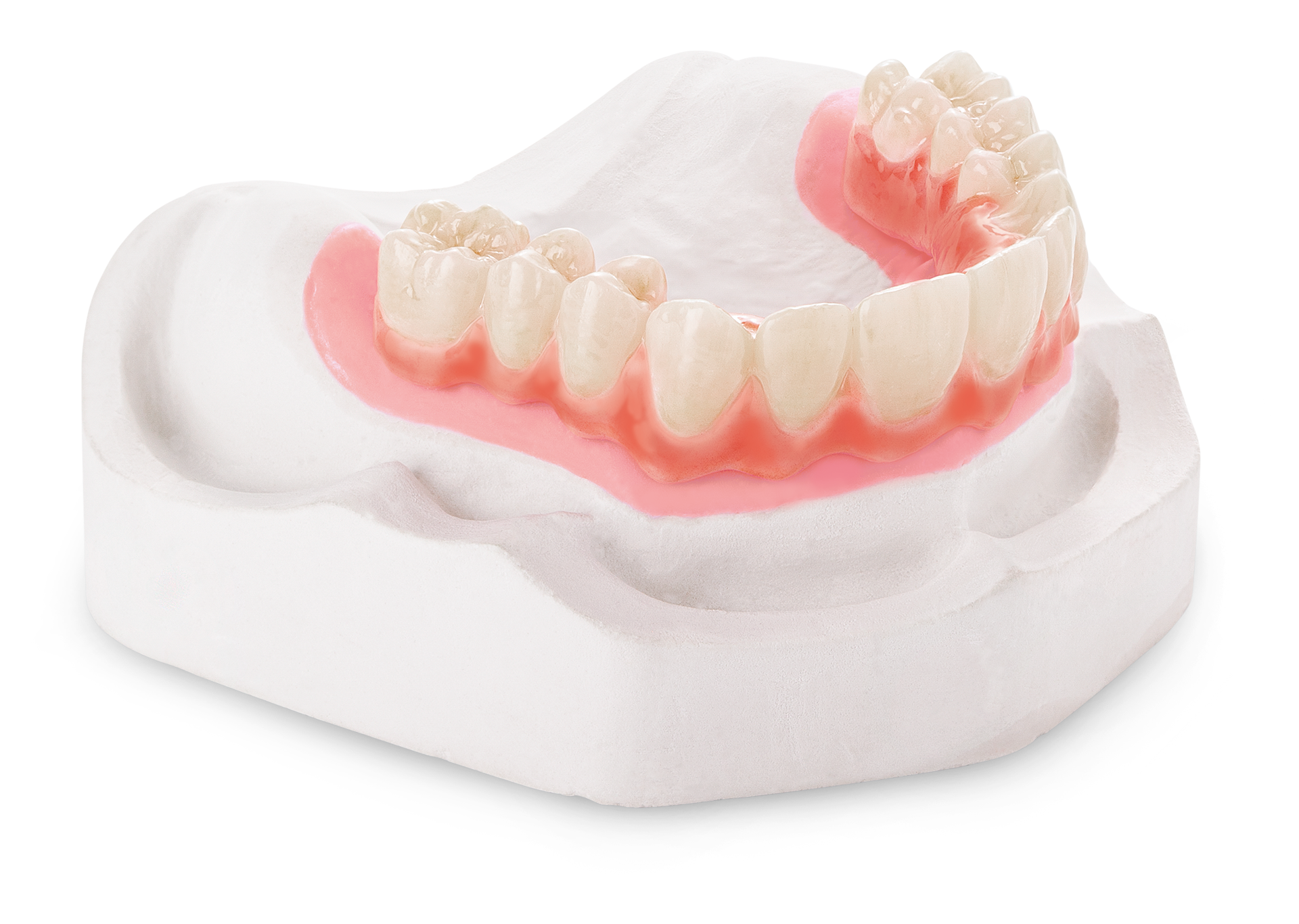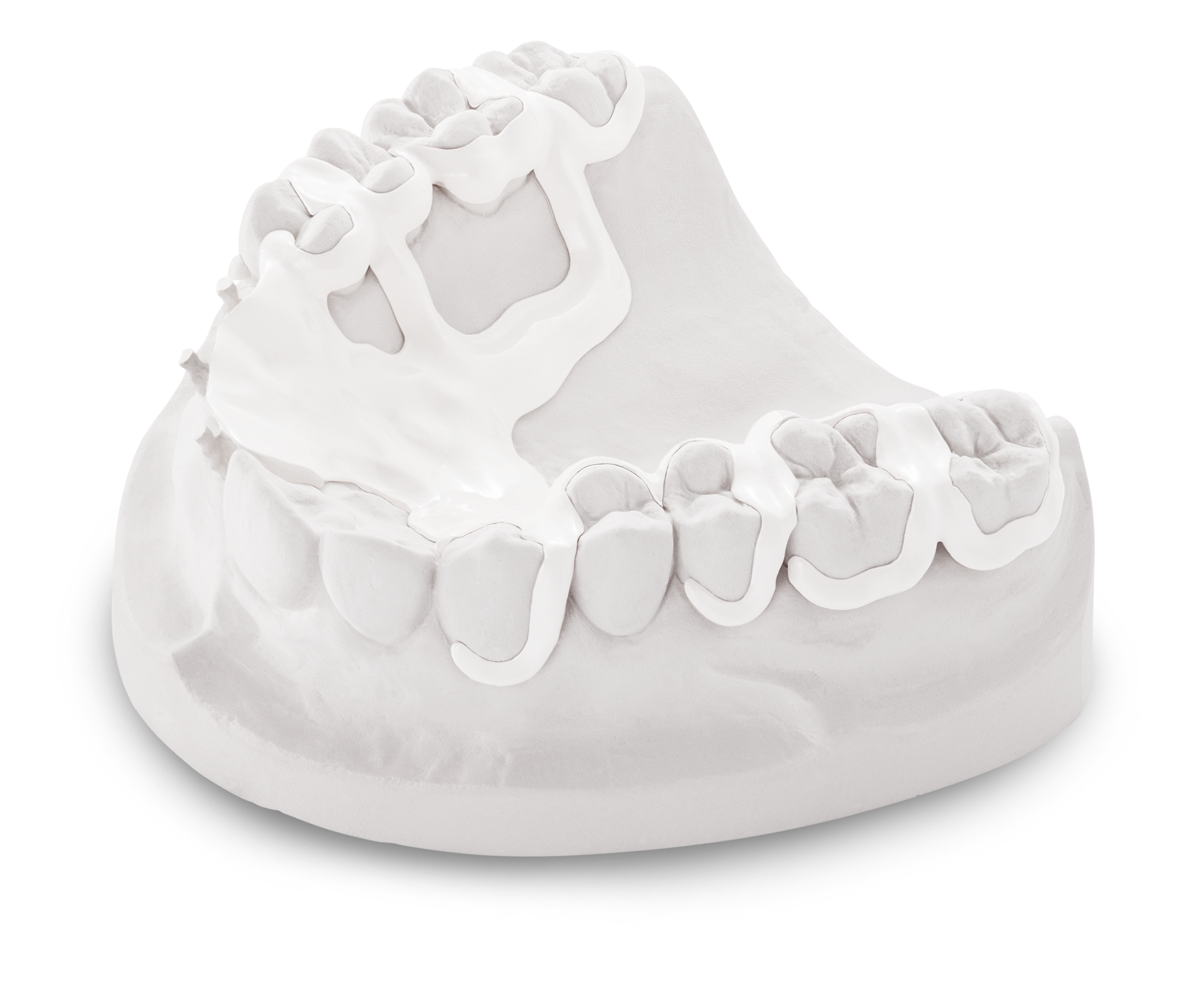Crown and bridge prosthetics in dental technology
Contents:
-
The history of the tooth crown
-
What is a tooth crown?
-
Types of crowns
-
What is a dental bridge?
-
Types of dental bridges
-
Crowns and bridges by type of material
-
Materials in crown and bridge prosthetics
-
Which veneering materials are available?
-
Manufacture of crowns and bridges for prosthetics
The history of the tooth crown
Let's first take a quick look at the very interesting history of dental prosthetics. In ancient Egypt, already 3500 years ago, teeth were glued on again using a mixture of honey and minerals, thus laying the foundation for dentures.
Nowadays, the valuable materials and the complex manufacturing process make the manufacture of dentures a highly complex and technically demanding task.
This is not only the case today, it was also a major challenge in the origins of dentistry. The first types of dentures or restoration similar to prosthetics were made of materials that are still considered to be of very high quality today. The ancient Maya used to wear dentures made of ivory or horn - a true status symbol.
In ancient Egypt, crowns and bridges were attached with gold or silk thread to the neighboring, healthy teeth, which were still present.
As you can already guess, these corrections are primarily of a cosmetic nature and could not restore the chewing function. As well, the fastening was only secured by a narrow and delicate gold wire. However, it could at least improve the pronunciation, which was impaired by missing teeth.
What is a tooth crown?
The tooth that protrudes from the gums in the oral cavity is called the dental crown in dentistry. A dental crown is also understood to mean the artificial crown as a dental prosthesis that is used in the event of a defect in the natural tooth. The purpose of the crown is to restore the natural function of the affected tooth and to protect it from tooth decay. If there is a complete loss of a tooth, the neighboring teeth are also crowned and serve as anchoring for dental bridges. To protect the function of the teeth and avoid major damage to the natural dentition, tooth gaps should always be closed promptly.
The dentist decides on the basis of the individual conditions in the patient's mouth whether a crown or bridge is possible.
If the stump is still worth preserving, it can be provided with a crown. However, if there is a tooth gap, two abutment teeth are required for the bridge restoration. The restoration is provided by a bridge pontic, which is attached to the adjacent teeth with the help of crowns / bridge anchors.
Partial crown
A partial crown only covers the damaged chewing surface. It is useful when a full crown has not yet been attached.
Full crown
The full crown, on the other hand, not only covers the damaged chewing surface, but also the entire crown of the tooth. Its function and aesthetics are based on the natural tooth.
Telescopic crown
The telescopic crown consists of an inner crown (also known as a primary or inner telescope) and an outer crown (also known as a secondary or outer telescope). It is used to attach removable dentures. The remaining teeth are used for anchoring.
What is a dental bridge?
In dentistry, a type of fixed denture that closes a tooth gap is called a dental bridge. Dental bridges are mostly used when teeth are missing or teeth have to be extracted due to damage. For the bridge restoration, the adjacent healthy teeth are ground and crowned as bridge abutments. The dentist replaces the lost tooth with a bridge pontic and thus closes the gap. The crowns adjacent to the pontic serve as anchoring to the abutment teeth. If there are no abutment teeth or if they are too badly damaged, implants or removable dentures are used.
Cantilever bridges
In order to achieve sufficient stability, this bridge construction requires at least two adjacent bridge abutments. A cantilever bridge covers a gap at the end of the still existing row of teeth. With this cantilever bridge, a maximum of one missing tooth can be replaced, since the lever arm would be too long due to additional teeth and the resulting forces on the abutment teeth would be correspondingly too great.
Inlay bridges
The inlay bridge is a bridge denture with fillings as anchors. An inlay bridge is mostly used for posterior teeth, since there is often enough substance in molars to fix the dental bridge with inlays.
Telescopic bridges
The telescopic bridge is a removable denture that is pushed onto the crowns firmly cemented in the mouth using the double crown technique.
Implant bridge
In contrast to the normal bridge, it is not worn on your own natural teeth, but on implants that are already anchored in the mouth.
Metal
The metal-based crown and bridge prosthetics can be made from an alloy with a high gold content, a gold-reduced alloy, titanium or a non-precious metal alloy (NPM) / cobalt-chromium (CoCr). The gold-reduced alloys can, however, cause allergies due to the addition of other metals. As a result of this problem, non-precious metals (NPM) such as cobalt-chromium (CoCr) or titanium were also developed as an inexpensive counterpart to the high-gold alloy.
All-ceramic
All ceramics is a generic term for a variety of materials such as zirconium oxide, lithium disilicate, glass ceramics and hybrid ceramics. These serve as a framework for veneering or as a monolithic (fully anatomical) crown/bridge.
Materials for bridges and crowns
The materials that are used in crown and bridge prosthetics are extensive and often consist of combinations such as ceramics and resins or precious metals and non-precious metals.
Each material has its specific properties and is therefore often used in combinations. If the appearance - as in the posterior region - plays a rather subordinate role, the strength is of great importance because of the strong stress caused by the chewing forces. Full cast crowns and full cast bridges are used in these areas. Tooth-colored crowns and bridges are usually used in the visible area; either so-called composite metal-ceramic crowns or all-ceramic crowns. Assessment and clarification is always done by the dentist. These are then discussed with the patient. Apart from the aesthetics, the focus is also on the financial outlay and influences the choice of materials.
Which veneering materials are available?
The veneering material can either be a veneering plastic based on composite or ceramic. In the case of plastics, the adhesive bond is created using an adhesion promoter. Due to the high firing temperature (800 - 900 °C), ceramic requires special firing alloys that form an oxide layer that promotes bonding during the firing process. Ceramic veneering is more complex to process and has aesthetic advantages over plastic veneering.
Manufacture of crowns and bridges for prosthetics
This branch of manufacture has changed significantly in dental technology. Nowadays, in addition to conventional wax modeling, crowns and bridges are digitally designed. Design programs such as 3Shape and Exocad are used for this. With the help of a scanner, the model is recorded digitally or made available directly by the dentist via an intraoral scan. There is no need to take an uncomfortable impression in the mouth of the patient.
Milling and LaserMelting processes ensure that the work is carried out safely and with high precision. A large variety of materials is available to the practitioner, so that monolithic full zirconium bridges, milled bridge prosthetics made of metal or veneer bridges can be manufactured using LaserMelting.
Are you currently spoiled for choice of the right material for your patient? Contact us! Our experts will be happy to advise you.

